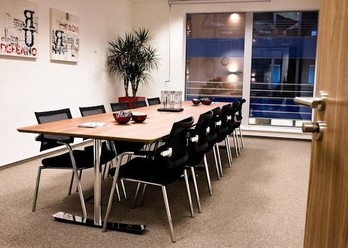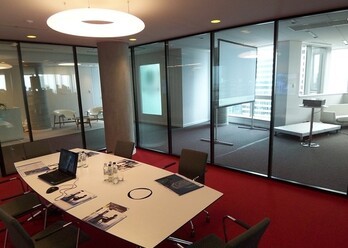Winners and losers of the real estate market
What changes have occurred on the commercial real estate market in 2020?
Real estate sector has shown that as a capital market it is immune to the crisis. The largest beneficiary of 2020 was the warehouse segment with a record-breaking transaction volume in history. The changes induced by the pandemic, the rapid growth of e-commerce and the transformation of supply chains increased the demand for warehouse facilities and logistics centers and drew investors' attention towards projects in this segment.
In addition, technology, which will soon revolutionize our work and operations, as well as the way office buildings and other commercial facilities function, has been introduced to all companies on a large scale. Building management systems as well as solutions and applications improving work are being launched. We are witnessing the rapid spread of modern solutions in the field of digitization, automation and digitization of business processes, as well as ecology and healthcare.
Last year introduced the transition from a traditional work model to a more flexible one and the initiated a hybrid work system. Some tenants have started analysis of the demand for office space in the new market situation, but most companies are still refraining from taking decisive actions. Hence, contract renegotiations were the most frequently chosen option by tenants last year. Nevertheless, the pandemic did not turn out to be an obstacle to the conclusion of spectacular lease contracts.
It will be crucial to get the economy back on track for retail, which has suffered the most. Modern centers in attractive locations are likely to strengthen their position even more. On the other hand, there is a real challenge for smaller and older facilities in worse locations. Some of them will have to consider different options, including changing functions. At the same time, it should be noted that in the new reality, smaller complexes, such as retail parks and convenience centers, which are now eagerly used by customers, have gained importance.
What direction is the market headed this year?
The biggest challenge this year is the situation related to the return to offices and the resumption of the operation of shopping centers in the context of changing the way of working and a radical change in shopping habits.The increasingly visible market trends include the increased activity of developers in the segment of land for investment, the development of last mile logistics and the diversification of portfolios by investors who will also head towards alternative investments forms such as, among others, PRS segment, student dormitories and data centers. We will also be monitoring investments in senior housing and healthcare projects. At the same time, investment opportunities in such facilities will be sought, not only by companies, but also by private investors, who are moving away from deficit investments.
General interest in plots of land is very high, which shows that developers and investors are ready to proceed with further investments and initiate new projects. We also see that developers are increasingly willing to implement projects in the JV form, partially sharing the profit in various arrangements with landowners.
The issue of implementing projects with environmental certificates is also becoming increasingly important to investors, which put investments in-line with such trends as zero energy balance, carbon footprint reduction and zero waste.
Automation in logistics makes the delivery time for online purchases shorter. Thus, warehouse complexes on the outskirts of cities are growing dynamically, including the SBU (Small Business Units). The warehouse segment not only turned out to be immune to the crisis, remaining the only one at the same rental level, but also greatly strengthened and continues to strengthen its position. In the upcoming years, warehouses will grow into an even greater star of the real estate market, and our country's position as one of the main logistics hubs on the continent will be increasingly stronger. In Poland, over 1.5 million sq m. of warehouse space is currently under construction, with over 70 per cent already leased.
How will the structure of demand for office space change in connection with popularity of home office? Will we see a wave of relocation this year?
We notice a large number of renegotiations, which account for about 50 per cent of transactions, while previously this ratio amounted to 20-30 per cent. The office market is in the process of changing, but contemplating its dusk is a major overstatement. A hybrid model that will permanently become a part of our lives will make offices different. How exactly different, we’ll find out only after the companies return to the offices on a larger scale and use them. Key decisions to change the workplace are still postponed until tenants can redefine their business model.
However, we see many signs that a full-time home office does not work due to the lack of opportunities for creative work, acquiring skills, training young employees, building relationships and ties with the company, as well as exchanging information. Therefore, traditional offices will remain fundamental to the functioning of the organization.
There is a visible decline in demand for space, but companies continue to lease offices. In the new system, companies are likely to work in different spaces, which will have to be flexible enough to adapt to the changing needs. Tenants are now looking primarily for safe offices in locations that allow easy access by public transport and their own means of transport. In facilities that provide numerous amenities and additional services, conducive to health and improvement of well-being. There is a demand for a space that fosters creativity and enables the arrangement of zones adapted for team meetings.
Can we expect an oversupply on the office market?
It will appear in some markets, but only in those where large new supply is planned. Thus, in some locations, the vacancy rate will increase, which will be a healthy change for these cities, as wider offer will bring more options.
At the same time, it should be mentioned that the construction slowdown is visible. Most of the development projects are carried out without delays, but in the case of some investments, it will be natural to postpone or even suspend the construction of projects. This applies to investments that are located in more disadvantaged areas. Such decisions will have a positive impact on the absorption of the existing space in a given area. Investors who prepare investments for construction are forced to look for the possibility of securing pre-lease contracts for a larger portion of the space. In these cases, tenants who decide to make such a move will most likely be eagerly rewarded.
We see indications that global corporations will locate new jobs in Poland. There is also a chance for business from Asia, Western Europe and the USA to relocate to our country, which will contribute to the increase in demand for offices. There is therefore no doubt that high-quality space in the main office markets in the country will continue to be sought.
Are investors still active in Poland? Which real estate sector do they mainly focus on? What were the last year results on the investment market?
The volume of transactions concluded and the amount of capital that global players invested in Poland last year, show that despite the turmoil, our country is a good and most importantly safe place to invest. This was also confirmed by numerous guests of the periodical Why Invest in Poland event, which we organized last year.
In 2020, the volume of investment transactions in Poland was a quarter lower than in the previous year, reaching EUR 5.6 billion. The warehouse segment dominated and accounted for almost half of the transactions. In the upcoming months, the demand for assets in this segment will probably remain at an equally high level. This is also visible in the expansion of land holdings. Recently, the most popular land among buyers were plots dedicated for logistic services. This is the hottest commodity on the real estate market, provided, however, that the plots have a building permit, because without it, investors are much less willing to buy.
Previously dominant office sector attracted almost 40 per cent of all investment transactions. As restrictions affected retail market the most, interest in commercial real estate was very low. Most of the transactions concerned smaller retail parks. The changes taking place on the market made investors look for alternative class of assets. The PRS and student housing sectors showed great dynamics, with several transactions carried out by funds that have not been previously present on the Polish market.
According to our analysis, in 2020, the warehouse market saw an interest rate compression of 0.25 per cent to 5.5 per cent, while the office market in the best locations it amounted to around 5 per cent. On the retail market, their amount changed by 0.5 per cent to 5.5 per cent per year.
The growing number of funds interested in our market, as well as the activity of entities already present on it, suggests that the dynamics of investment transactions this year will be growing and we may be able to see more records.
What was last year like for Walter Herz? What are the company's plans for this year?
2020 was a year full of challenges and intense activities. We can safely say that it turned out to be very good for us. In recent months, we had the opportunity to conduct many spectacular and record-breaking transactions for the company, as well as organize Why Invest in Poland event, attended by over 500 guests from 76 countries. Summing up the meetings, we can say that the mood among global investors is very positive, which bodes well for the transaction procedures this year and the years to come.
Our plans for this year are related to the further development of the department responsible for office and investment sector, as well as the expansion of structures responsible for warehouse segment.




